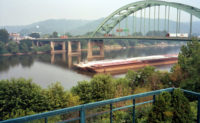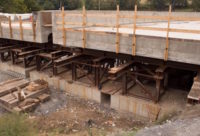The tunnel boring machine drilling a new 5,700-ft-long tube for the Chesapeake Bay Bridge-Tunnel in Virginia has made major headway since its launch in late February—with the 3,000-ton, 308-ft-long Herrenknecht-built machine progressing 400 ft before halting for its first scheduled maintenance check in early May.
Located adjacent to the original 60-year-old, 17.6-mile bridge-tunnel system’s tube at Thimble Shoals Channel, about 3.5 miles offshore from Virginia Beach, the new tunnel is part of a $756-million project to eliminatie a longstanding bottleneck by connecting parallel above-water segments constructed in 1995 to carry southbound traffic.
The project is being led by Chesapeake Tunnel Joint Venture, comprised of Dragados USA and Schiavone Construction Co. LLC.
To ready the TBM, called "Chessie," for what is expected to be a year-long journey through sand and varying strata of clay, the firms expanded the original tunnel’s two 5.25-acre artificial islands to accommodate both launch and receiving pits, as well as the eventual tunnel entrances. Along with removing approximately 500,000 cu yd of soil, the machine crew will install more than 9,000 precast segments for the new tunnel.
Although the project broke ground in 2017, progress was stymied in part by difficulties excavating large boulders installed as armoring for the artificial islands during the bridge-tunnel system’s original construction in the 1960s. That issue, along with permit delays and dismissal of the original geotechnical subcontractor, have added four years to the project’s original 2022 completion date.
Mike Crist, deputy executive director of infrastructure for the Chesapeake Bay Bridge and Tunnel District, the project owner, declined to comment on any financial claims stemming from the delay.
The expansion is one of two major highway tunnel construction projects underway in southeast Virginia. Preparations are underway to begin boring two new 7,500-ft-long tubes for the Virginia Dept. of Transportation’s $3.9-billion Hampton Roads Bridge-Tunnel Expansion project. The state’s largest-ever infrastructure effort will double the existing capacity of the existing four-lane bridge-tunnel crossing combination at the mouth of the James River between Norfolk and Hampton.
According to VDOT, the 400-ft-long, 4,000-ton TBM “Mary,” also built by Herrenknecht, has made her initial cut into the headwall, supported by is the slurry treatment plant, nicknamed “Katherine.” Both honor “Hidden Figures” mathematicians Mary Jackson and Katherine Johnson, who worked at NASA’s nearby Langley Research Center. The expansion project is being led by a design-build joint venture of Dragados USA, Flatiron Constructors, Vinci Construction, and Dodin Campenon Bernard. HDR and Mott MacDonald are lead designers.
VDOT anticipates Mary to travel approximately 50 ft per day and complete the first tube in approximately a year. The machine then will be turned 180 degrees to construct the second tube. VDOT says more than 640 piles have been driven into the seabed to support future bridge structures connecting the new tubes to land. The project’s 9.9-mile corridor also includes widening landside four-lane sections of I-64 on both sides of the crossing from four to six lanes, with two part-time drivable shoulder lanes for peak travel periods.
A VDOT spokesperson says that while the design-build team has fallen behind schedule, the project’s contract completion date remains November 2025.



